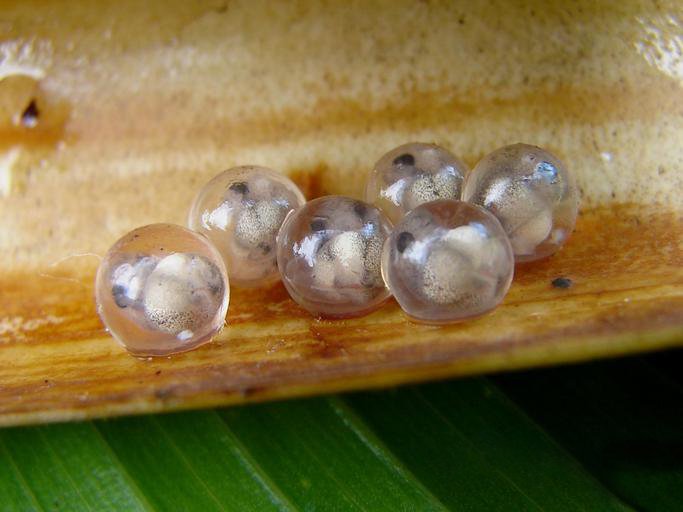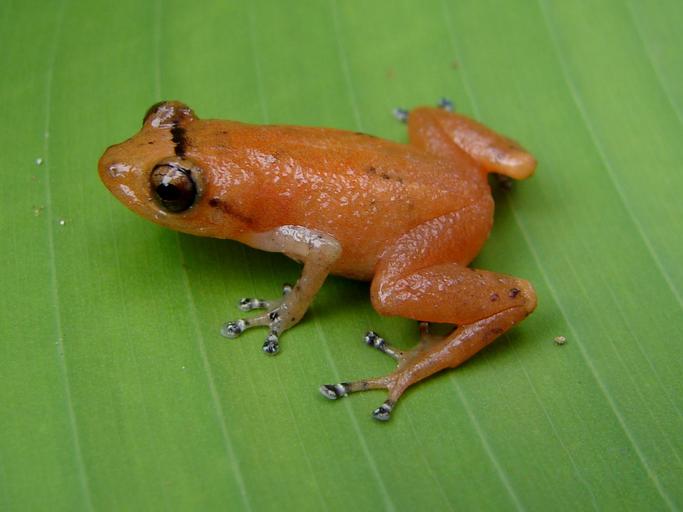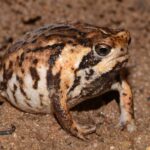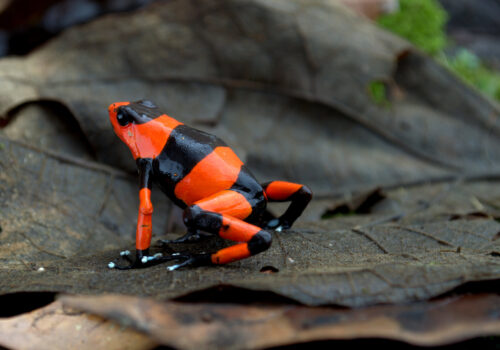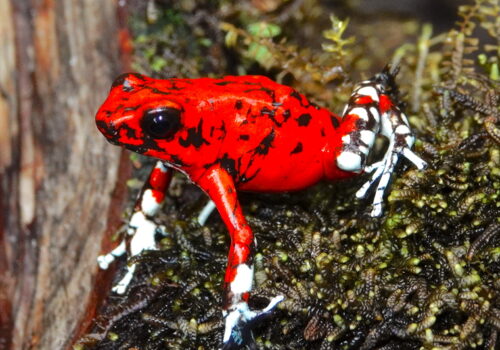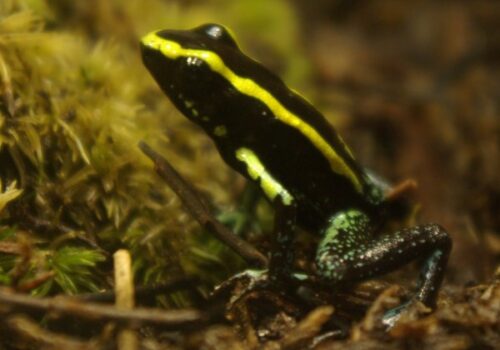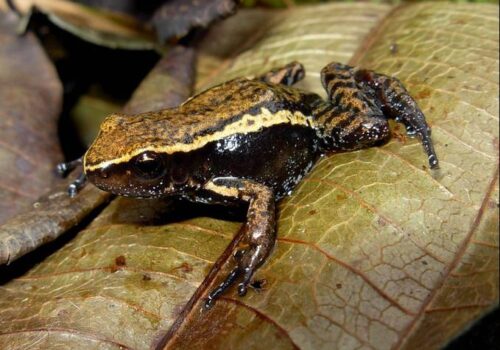- Introduction: A Hidden Gem of the Rainforest
- Taxonomy and Classification
- Natural Habitat: Mystical Depths of the Amazonian Rainforest
- Physical Characteristics: Subtly Beautiful and Highly Adapted
- Behavior and Life Cycle: Fascinating Strategies in Survival and Reproduction
- Ecological Role: Integral Links in a Complex Chain
- Threats and Conservation Status: Guardians Needed in Times of Change
- Cultural and Scientific Significance: Connecting Wilderness and Wonder
- Conclusion: Guardians of the Amazon's Hidden Wonders
Introduction: A Hidden Gem of the Rainforest#
Deep in the lush, verdant embrace of South America’s Amazon basin, concealed within leaf-littered forest floors and gently flowing streams, lives a small yet captivating amphibian. Known scientifically as Hyloxalus eleutherodactylus, this remarkable frog embodies the delicate balance of rainforest ecosystems. At first glance, one might easily overlook its presence—camouflaged perfectly amongst damp foliage and mossy stones—but beneath its humble exterior lies an extraordinary creature, vital to the health of its aquatic and terrestrial habitats.
Although relatively obscure in mainstream wildlife documentation, this species possesses fascinating characteristics, from unique parental strategies to compelling behavioral adaptations. As ecological indicators, these frogs inform scientists about the health of their forest homes, acting as frontline ambassadors for broader conservation efforts. Journey with us as we unveil the remarkable life of Hyloxalus eleutherodactylus, a species quietly holding secrets critical to the preservation of biodiversity in one of Earth’s most inspiring regions.
Taxonomy and Classification#
Hyloxalus eleutherodactylus belongs to the diverse amphibian family Dendrobatidae, a group widely recognized as poison dart frogs. Unlike some of its brighter-colored cousins, such as the infamous Dendrobates tinctorius, members of the genus Hyloxalus tend to bear subtler earth-toned coloration, earning attention not through vibrant appearance but through their fascinating reproductive behaviors and critical ecological roles.
The specific epithet “eleutherodactylus” suggests certain physical or behavioral similarities to frogs from the genus Eleutherodactylus, known primarily for their direct-developing embryos that bypass a free-living tadpole stage. However, despite the naming, tadpoles of Hyloxalus eleutherodactylus indeed still develop aquatically, creating fascinating evolutionary contrasts to explore. Understanding the taxonomy helps illuminate the intriguing contradictions folded into this species’ evolutionary narrative.
Natural Habitat: Mystical Depths of the Amazonian Rainforest#
Geographic Distribution#
Hyloxalus eleutherodactylus finds its home scattered throughout the richly biodiverse regions of Ecuador, Peru, and parts of Colombia. Preferring undisturbed humid tropical forests nestled between lower mountain elevations and lush lowland jungles, these amphibians showcase notable adaptability while maintaining specific preferences. The frogs favor pristine forested territories, especially near clear, slow-moving streams and delicate pools shaded by dense jungle foliage.
The Ideal Home: Cooler, Shaded, and Moist#
The species predominantly occupies moist environs characterized by dense leaf litter, moss-covered rocks, fallen logs, and proximity to freshwater sources. These habitats offer necessary humidity, protection from predators, and an abundant supply of insect prey. Such secluded microhabitats often create small ecological islands, promoting niche specialization and interesting behavioral adaptations among resident forest amphibians, including Hyloxalus eleutherodactylus.
Among tangled roots and richly decomposing foliage, the frog skillfully maneuvers through an intricate maze of microenvironments. This habitat selectivity ensures separation from direct sunlight while also providing safety from visually oriented predators. In these shadowy, damp recesses of the rainforest, these frogs thrive discreetly alongside numerous other cryptically colored fauna, each organism perfectly adapted to the challenges and opportunities present within this complex arrangement.
Physical Characteristics: Subtly Beautiful and Highly Adapted#
The modest appearance of Hyloxalus eleutherodactylus belies an elegance shaped by evolutionary necessity. Measuring between 15 to 25mm in length, these frogs fit comfortably on a fingertip. Their compact, muscular bodies indicate agility and stealth as much as delicate beauty. Unlike vividly pigmented relatives, their coloration leans toward subtle earth tones—shades of brown, olive-green, grey, and tan intricately patterned to mimic leaf litter—providing crucial camouflage.
Subtle chocolate-colored markings often adorn their backs, complemented by paler undersides. Small granular bumps across their skins provide texture vital to their disguise. Their flexible limbs, equipped with agile toes terminating in small adhesive pads, facilitate precise maneuverability through tangled vegetation—feats necessary for evading predators and skillfully ambushing unsuspecting prey.
Though lacking brightly colored warnings, this species offers fascinating insights into alternative survival strategies such as cryptic coloration and behaviorally driven avoidance tactics. This camouflage represents a perfect example of evolutionary ingenuity, enabling frogs to thrive confidently yet unobtrusively in their rainforest habitats.
Behavior and Life Cycle: Fascinating Strategies in Survival and Reproduction#
Ingenious Hunting and Diet#
Everyday life for Hyloxalus eleutherodactylus involves an intricate dance with prey and predators. Efficient hunters, their diet primarily consists of tiny insects, including ants, termites, springtails, and various other invertebrates abundant within their leaf-litter habitats. Using a combination of ambush and active search strategies, these frogs expertly capture their meals. Their remarkable tongues quickly snap prey into their mouths, ensuring swift and secure feeding experiences.
Unique Breeding Behaviors and Tadpole Development#
Reproductive behaviors introduce the genuinely captivating characteristics of this species. Breeding typically aligns with rainy seasons when freshwater habitats become replenished and safe for tadpole development. Males issue soft, chirrup-like calls designed to attract mates, a gentle melody easily lost amidst the vibrant cacophony of the Amazonian night chorus. Females carefully select suitable mates based on auditory and territorial displays.
Unlike certain amphibians producing large egg masses, Hyloxalus eleutherodactylus exhibits remarkable parental investments—females lay small clutches of eggs usually hidden beneath moist leaves or logs. Both parents may guard the developing embryos dedicatedly against predation and dehydration, demonstrating strategic parental care uncommon in many amphibian families. Upon hatching, tadpoles are gently transported by parents to suitable aquatic habitats, meticulous journeys often requiring considerable distance and precision navigation. This parental devotion highlights remarkable evolutionary investment into offspring survival, showcasing a surprisingly tender parental bond unfolding discreetly under dense rainforest canopies.
Ecological Role: Integral Links in a Complex Chain#
Within the interconnected web of rainforest life, Hyloxalus eleutherodactylus fulfills multiple roles vital for healthy ecosystem function. As efficient insect predators, these frogs help regulate populations of small forest-floor invertebrates, maintaining balance preventing outbreaks detrimental to plant growth and biodiversity.
These small amphibians simultaneously occupy critical positions within food webs—providing sustenance for various predators like small snakes, birds, and even larger amphibian species. Their population health directly reflects broader environmental stability, thus serving effectively as bio-indicators frequently monitored to detect ecological disturbances or environmental degradation, acting as ecological sentinels whose presence or absence sounds alarms regarding habitat health.
Threats and Conservation Status: Guardians Needed in Times of Change#
Despite adapting impressively to rainforest challenges, Hyloxalus eleutherodactylus faces concerning threats common to amphibians globally. Habitat destruction, logging, agricultural expansion, and climate-induced alterations in rainfall patterns drastically impact their delicate habitats. Additionally, emerging diseases such as chytridiomycosis exert considerable pressure, threatening amphibian populations worldwide.
To date, detailed data on its exact conservation status remain limited, yet experts advocate proactively safeguarding pristine habitats and targeted monitoring measures. Establishing protected regions and supporting local conservation initiatives are vital strategies towards securing these fascinating but vulnerable frogs’ ecological future.
Cultural and Scientific Significance: Connecting Wilderness and Wonder#
Traditionally, local indigenous cultures revere rainforest creatures as symbols of ecosystem health and biodiversity. Biologically, the frogs fascinate researchers exploring amphibians’ evolutionary intricacies, reproductive strategies, parental care in vertebrates, ecological adaptations, and environmental sensitivity.
Conclusion: Guardians of the Amazon’s Hidden Wonders#
The story of Hyloxalus eleutherodactylus serves as an evocative testament to life’s subtle resilience and interconnectedness. Protecting and appreciating such humble species obligates us toward broader responsibility towards preserving Earth’s delicate ecological treasures. Join ongoing conservation conversations, support protective legislation, and further advocate amid these invisible wonders’ hidden, elegant worlds.

